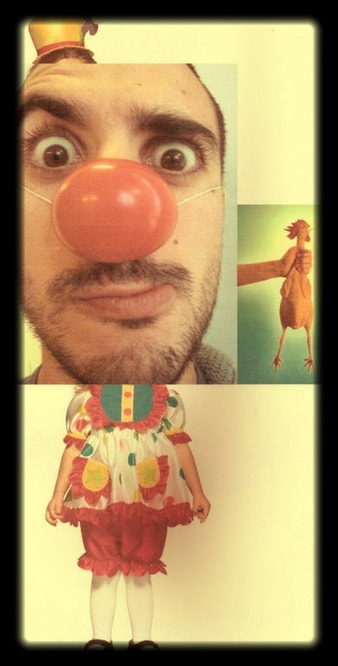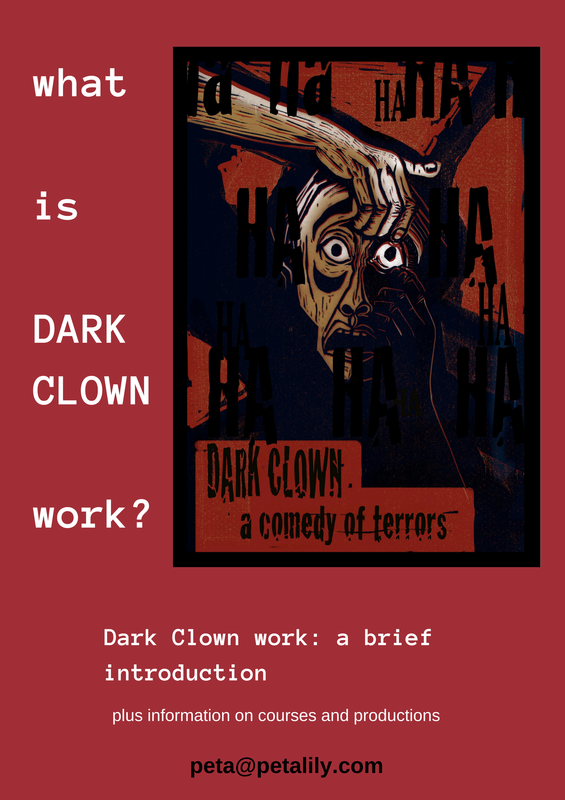
This lighthearted list is a work in progress. These principles are in no way intended as a complete approach. A number of them will make more sense for people who have taken part in a workshop already and know my thoughts on the importance of rhythm in Clown and comedy work:
A key principle at the very start:
Create the Conditions for Comedy – think about how circuses would always play music with the tempo of a happy heartbeat as the crowd entered the tent
Charm – ‘Where does a laugh start? In the eyes.’ (Philippe Gaulier). Before they laugh, you need to be watchable, and charm their both their attention and their breathing
Create Communion – Casting the net helps (this makes sense when you have done a workshop with me but you can also look at the post on 31 January) other teaching phrases I play with are 'sniff the beast' and 'sense the field'. A student recently said: 'Allow yourself to be received', which I love.
Clarity – was your gag / idea / execution / voice Clear enough? (If they didn't see/hear it, it didn't happen)
Clear the head– find a good teacher or book on Chi Gung (I recommend Master' Lam Kam Chuen: The Way of Energy') and learn how to get on your Hara! It creates more mental space and more opinionless-ness so you are ready to respond more Creatively (i.e. download something direct from the Imaginal realm which is all around us - take that for your own testing, but honestly, where else do spontaneous ideas come from?)
Contrast – one of the most basic building bricks of Comedy - things were one way and now they are another way, surprise!
Contact – with audience, with Co-performers – light, flexible, agile, open-minded Contact keeps you Connected (see Complicité also - many articles have been written about or include reference to Complicité like this one )
Commune – an aspect of Contact and Community. Remember that the Clown also likes to Commune with inanimate objects
Complicité – a useful Concept well known by Philippe Gaulier graduates
Cumulative – laughter is cumulative – I discovered that if I missed a laugh in a building gag in performance, the laughter at the final punch was not as high as it usually was (see my earlier post on Laughter)
Cap the gag - do you have a few actions you found in improvising? make sure the one with the biggest laugh is at the end or you risk to create a dying fall
Compassion for self – are you bracing with fear? Calm and Comfort yourself (Gaulier used to say 'sing yourself a lullaby')
Calm – using the Hara helps the aspiring Clown (or any performer) be more flexibly alert, agile and opinionless, more 'zen'
Compassion for your audience – are they not laughing? Well, then, rather than bracing against them - think: 'how interesting, they aren't laughing yet'. It's the Clown's job to lift the heart of the 'sad normals'. Love them. Interest yourself in how to lift their hearts.
Choices – you’ve done it 3 times – do you do the 4thwith a variation? Do you expand, accelerate? Do you elaborate? If you a revisited by a successful reaction motif then do you alternate the original motif with the reaction motif, do you, alternate with a call back to a previous thing? Do you abandon hat game (with the option of revisiting it later?)
Carry on – after a failure, do something else – a big soft burst of elastic energy can be helpful (even if you’ve no idea what you are going to do on the other side of it!)
synCopation – the bass line is the rhythm of a happy heartbeat – on top – think jazz, think tiCkle rhythm, think unprediCtable
Calibrate - ABC – Always Be Calibrating (in the play Glengarry Glennross the salesmen are taught to Always Be Closing. Ok you don't need to do it ALWAYS. But it does provide a useful way to stay present (and build awareness). Practice Calibration (measuring) – 'How were they before they laughed? how are they now? How much did they laugh? Did all of them laugh or only three? Was I expecting more or less reaction? How does that make me feel? What if I do it again – calibrate the response – is it satisfyingly the same or less? Or better? How do i feel about that? What is happening with the audience now?' (all this is done by the performer within the clown - or as Gaulier described...the scientist (see further below).
Check - check the audience's reaction, their breathing, the look into their eyes (see above) - Check in with yourself - the audience loves to watch the clown think and feel ... don't slide over your inner emotional beats. Separate checking from doing. Do, check, re-do, check.
Clock - when you hear a laugh, look - or even better to say 'deliver your face to the audience. Clocking is turning your (clock) face to the audience, in the direction of laughter. You are not looking for approval, simply aCknowledging the laugh - as Avner the Eccentric says: 'Laughter is an interruption that must be dealt with'. Clocking is a comedic term for delivering the face to the audience. It's a notiCing, but it's also a sharing. It gives a chance to Connect - to remind the audience there is no fourth wall.
Count – dare for the rule of three – if something goes wrong you probably either lost Contact, lost your joy, ignored a reaction from the audience, ignored an impulse inside yourself etc. Embrace the opportunity to aCknowledge the failure (it's the Clown's job to show its Humanity) and move on
aCknowledge the laugh – if a tiny seedling appeared in your garden would it be wise to ignore it, let it die?
also
notice and aCknowledge silences ... 'Failure' is, for the Clown, an opportunity to show humanity, and to Connect with the audience
Courage - hang in there and try to Care less - cultivate Curiousity
Curiousity - as Avner the Eccentric says: 'Don't try to be interesting, be interested.' Interested in everything - the environment, the objects in it, the audience, in what you are doing...
Charisma – Casting the net and the Lighthouse exercise help with this. You can also practice imagining a little spark about seven centimetres above your crown
Comfort and Calm – if you make an abrasive noise you may need to Comfort and Calm your audience
inClude – things your partner is doing, responses from the audience (unless you have a troublesome audience member who needs to be Calmed and Controlled – advanced stuff but sometimes you need to take Charge).
Consistency - Gaulier said: 'If it made them laugh once, it should make them laugh again' - he described the Clown as working with interest, like a scientist...'hm, that's interesting, what if I repeat the experiment?'. Develop and finesse the skill of proprioception (body feeling) where were you, what position were you in , what vocal timbre and volume were you using, just before the laugh? Is it possible to deliver exactly that again? Think of Tommy Cooper: 'just like that'
inCorporate – bring back something successful from before (known in standup as a ‘Call back’)
Confusion – can be good
Concision – Writing a Comedy sCript? Hone it! – excess words (unless they are building rhythm or creating suspense) can stop the yuks. In terms of comedic movement, make your laughter 'nudge'** clear and succinct (**note to self: I need to write a post on nudges)
Circulation – ok this is a stretch but it's a C word way to introduce another key concept. It is useful to think of people's hearts and their heart rate! Carlo Boso once said: 'It's easy to make an audience laugh, all you need to do is to control their breathing and their heart rate.' People who have done my workshops will have experienced me guiding people to discover how that might be done (the importance of rhythm).
Curves – movement works better using curves, and secret curves (including eye muscles) - come to a workshop to learn more
musiCality – useful generally and especially necessary in Dark Clown work
no hypoCrisy – another piece of Gaulier's wisdom, a funnier and crisper way of saying 'be authentic'. It also helps you stay in step (create Community) with your audience. It is important to notiCe and aCCept the audience’s reaction - do not assume it.
Now of course, annoyingly, some other handy Concepts do not contain C words – for example:
fixed point, joy, élan…
sigh, it’s not a perfect world
which is exactly why we need
the
Clown
 RSS Feed
RSS Feed
